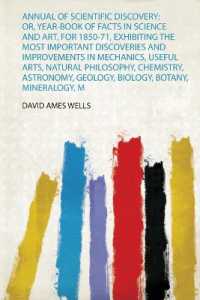- ホーム
- > 洋書
- > 英文書
- > Juvenile Grades 7-9
Full Description
Bebop music is more than a jazz movement that seemed to have burst suddenly upon the jazz scene—it is an outgrowth of the sociocultural environment dating from the 1920s through the 1940s. In this consideration of the period and its music, noted jazz scholar Eddie S. Meadows traces the cultural and ideological context that produced Bebop and advocates that Cool Jazz was a reaction to Bebop, a natural outgrowth of its predecessor. Unlike most jazz research on the subject, ^IBebop to Cool^R features insider perspectives on both the social context of the music and the music itself, as a means of capturing the musical aesthetics and the cultural spirit of the time.
The volume includes the perspectives of Marcus Garvey, W. E. B. DuBois, and other leaders of the Harlem Renaissance; also discussed here for the first time is the role that Islam played in the music's development. Finally, in identifying and discussing the work of such significant musicians as Miles Davis, Dizzy Gillespie, Thelonious Monk, Charlie Parker, and Stan Getz, Meadows demonstrates their unique musical identities within the respective genres that compose the revolutionary Bebop and Cool Jazz movements.
Contents
Introduction New Thoughts, New Directions Sociocultural Context Ideology Musical Appropriation The Transformation to Bebop Bebop: Articulating Language and Identity Playing Bebop General Musical Characteristics of Bebop Bebop Scales The Musical Language of Dizzy Gillespie The Musical Language of Charles Parker The Musical Language of Thelonious Monk Cool: Articulating Language and Identity Cool Jazz The Musical Language of Miles Davis The Musical Language of Stan Getz The Musical Language of Lennie Tristano Conclusions Appendix: Transcriptions Discussed in the Book Glossary References Index








